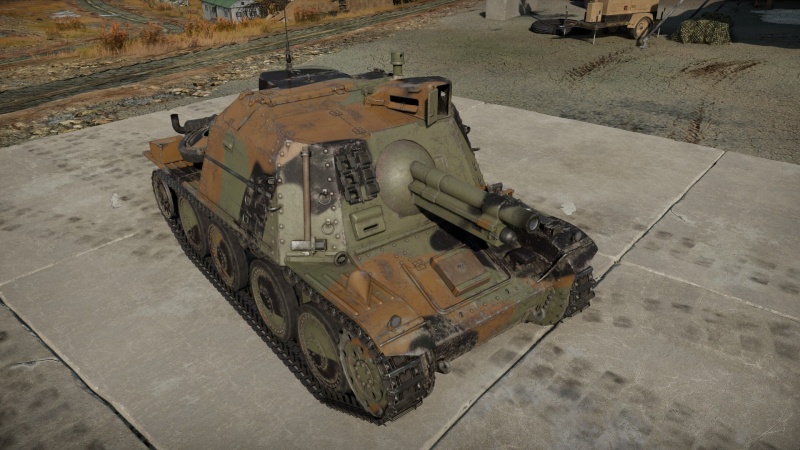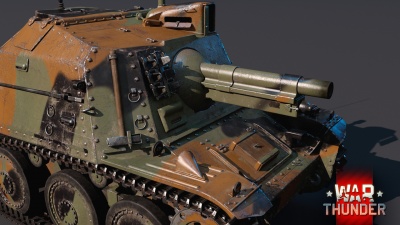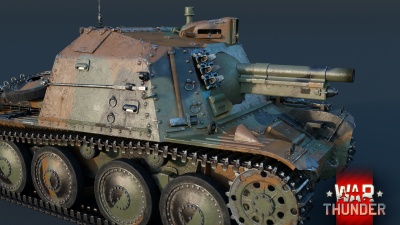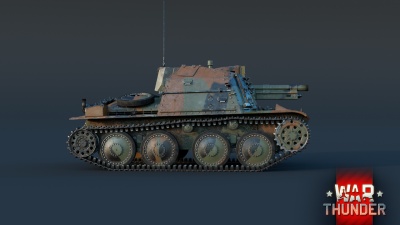Sav m/43 (1944)
| This page is about the Swedish tank destroyer Sav m/43 (1944). For the later version, see Sav m/43 (1946). |
Contents
Description
The Stormartillerivagn m/43 (1944) was an assault gun vehicle based on the chassis of the Strv m/41. Similar to the German StuG III, they removed the turret and built a casemate to be able to equip a more powerful gun than the previous 37 mm Kan m/38 for its intended purpose of being able to provide support. When the Army stopped its order of 122 Strv m/41 S-II, they had already acquired a total of 104 that were completed. The remaining 18 were repurposed to become support vehicles to the different artillery regiments as assault gun divisions. The Sav m/43 was supposed to be armed with a 105 mm Kan m/44, but the order for these cannons would take a while so the first 18 vehicles were equipped with the older 75 mm Kan m/02 as a temporary solution. They were all supposed to be delivered in November 1944, but issues occurred with the production and it wouldn't be until January 1945 when all were delivered. Between 1945 and 1946, all the Sav m/43 (1944) would be equipped with its intended gun, along with an order of an additional 18 Sav m/43s, and it wouldn't be until late 1947 that all the units were completed and deployed where they would serve the Swedish Army in different regiments throughout the years in service until its final fate of being decommissioned in early 1970s.
Introduced in Update 1.97 "Viking Fury", the Sav m/43 (1944) is a bit cumbersome compared to the previous Ikv 72 but better frontal protection and can be used in a similar playstyle. The Sav m/43 (1944) is best used in an hull down position or using it in a supporting role either as a distraction to take away attention from allied units that can flank around the enemy or it can use its larger 75 mm gun to deal a finishing blow to an enemy vehicle. The Sav m/43 (1944) is also a suitable ambush tank, waiting behind a hill using its gun depression while also utilizing the effectiveness of the armour to increase its survivability if taking fire. However, compared to the Ikv 72's 75 mm Kan m/41, the Sav m/43 (1944)'s Kan m/02 is an older cannon and doesn't have the same efficiency and will not perform as well, but it's still a decent 75 mm and can be utilized by flanking around the map and trying to hit targets on their weaker side or rear armour.
General info
Survivability and armour
The Sav m/43 has up to 50 mm of armour in front, which is capable of deflecting some guns commonly encountered but is still vulnerable to larger calibres. It has better frontal protection than the Ikv 72, but is still rather lightly armoured from other angles. The engine deck is only 10 mm thick, and can be penetrated by aircraft heavy machine guns and cannons. The side armour is only 15 mm thick at most, and can also be penetrated quite easily by heavy machins guns and autocannon fire. Due to the cramped crew compartment and scattered ammunition within the compartment, any penetration by a shell is likely to cause critical damage to multiple modules and/or crew members.
Armour type:
- Rolled homogeneous armour (hull, casemate)
- Cast homogeneous armour (gun mantlet)
| Armour | Front (Slope angle) | Sides | Rear | Roof |
|---|---|---|---|---|
| Hull | 30 mm (64°) Upper glacis 50 mm (15°) Lower plate 15 mm (61°) Bottom glacis |
15 mm | 15 mm (13°) 10 mm (59-64°) Engine cover |
30 mm (26°) Front glacis 10 mm (2-17°) Engine deck |
| Casemate | 50 mm (23°-24°) Turret front 50 mm (spherical) Gun mantlet |
13 mm (14°) Bottom 13 mm (38°) Top 13 mm (0-7°) Bustle |
13 mm (13°) Bottom 13 mm (44°) Top 13 mm (13°) Bustle |
13 mm (11°) Front 13 mm (3°) Rear |
Notes:
- Belly armour is 20 mm thick.
- Mudguards are 4 mm thick.
- Suspension wheels, tracks, and torsion bars are 15 mm thick.
- A 10 mm plate separates the crew compartment from the engine compartment.
Mobility
| Game Mode | Max Speed (km/h) | Weight (tons) | Engine power (horsepower) | Power-to-weight ratio (hp/ton) | |||
|---|---|---|---|---|---|---|---|
| Forward | Reverse | Stock | Upgraded | Stock | Upgraded | ||
| Arcade | Expression error: Unexpected * operator. | 227 | Expression error: Unexpected round operator. | __.__ | |||
| Realistic | 142 | Expression error: Unexpected round operator. | __.__ | ||||
The Sav m/43 is based on the chassis of the Strv m/41 and thus has a similar level of mobility. It is considerably heavier, however, and thus correspondingly more sluggish. While the forward top speed is adequate, the reverse speed is quite poor, making it hard to retreat. It is also noticeably slower than the Ikv 72.
Modifications and economy
Armaments
Main armament
The Sav m/43 is armed with the 7,5 cm kan m/02, an older and weaker 75 mm field gun compared to that used in the Ikv 72. It has wider traverse arcs and higher maximum elevation, but less gun depression than the Ikv 72, though still quite good at -10 degrees. It starts off with the unremarkable slpprj m/40 uncapped AP shot, which is adequate against most opposition it may encounter but tends to suffer ricochets against sloped armour. However, once upgraded, the gun may fire the slpgr m/39 uncapped APHE shell and the slpprj m/40B APBC shot. The former round has a very lethal 260 g TNT filler but tends to ricochet more and has less penetration, while the latter has better penetration and ricochets less, and is thus more useful in uptiers. It is recommended to carry a mixture of both APHE and APBC unless the Sav m/43 is top tier, in which case the APHE alone is sufficient.
| 75 mm kan m/02 | Turret rotation speed (°/s) | Reloading rate (seconds) | |||||||||||
|---|---|---|---|---|---|---|---|---|---|---|---|---|---|
| Mode | Capacity | Vertical | Horizontal | Stabilizer | Stock | Upgraded | Full | Expert | Aced | Stock | Full | Expert | Aced |
| Arcade | 80 | -10°/+25° | ±15° | N/A | 7.0 | 9.8 | 11.8 | 13.1 | 13.9 | 7.67 | 6.79 | 6.25 | 5.90 |
| Realistic | 4.8 | 5.6 | 6.8 | 7.5 | 8.0 | ||||||||
Ammunition
| Penetration statistics | |||||||
|---|---|---|---|---|---|---|---|
| Ammunition | Type of warhead |
Penetration @ 0° Angle of Attack (mm) | |||||
| 10 m | 100 m | 500 m | 1,000 m | 1,500 m | 2,000 m | ||
| slpprj m/40 | AP | 69 | 67 | 60 | 52 | 45 | 39 |
| sgr m/22-38 | HE | 9 | 9 | 9 | 9 | 9 | 9 |
| slpprj m/40B | APBC | 68 | 66 | 58 | 50 | 43 | 37 |
| slpgr m/39 | APHE | 51 | 49 | 43 | 36 | 30 | 25 |
| Shell details | ||||||||||||
|---|---|---|---|---|---|---|---|---|---|---|---|---|
| Ammunition | Type of warhead |
Velocity (m/s) |
Projectile mass (kg) |
Fuse delay (m) |
Fuse sensitivity (mm) |
Explosive mass (TNT equivalent) (g) |
Ricochet | |||||
| 0% | 50% | 100% | ||||||||||
| slpprj m/40 | AP | 501 | 6.6 | - | - | - | 47° | 60° | 65° | |||
| sgr m/22-38 | HE | 496 | 6.6 | 0 | 0.1 | 550 | 79° | 80° | 81° | |||
| slpprj m/40B | APBC | 505 | 6.3 | - | - | - | 48° | 63° | 71° | |||
| slpgr m/39 | APHE | 496 | 6.5 | 1.2 | 9 | 260 | 47° | 60° | 65° | |||
| Smoke shell characteristics | ||||||
|---|---|---|---|---|---|---|
| Ammunition | Velocity (m/s) |
Projectile mass (kg) |
Screen radius (m) |
Screen deploy time (s) |
Screen hold time (s) |
Explosive mass (TNT equivalent) (g) |
| rökgr m/22 | 496 | 6.6 | 13 | 5 | 20 | 8 |
Ammo racks
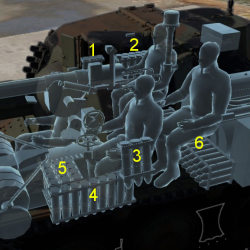
| Full ammo |
1st rack empty |
2nd rack empty |
3rd rack empty |
4th rack empty |
5th rack empty |
6th rack empty |
Visual discrepancy |
|---|---|---|---|---|---|---|---|
| 80 | 78 (+2) | 67 (+13) | 64 (+16) | 55 (+25) | 43 (+37) | 1 (+79) | No |
Notes:
- Shells are modeled individually and disappear after having been shot or loaded.
- If you pack 16 (+64) shells, it will keep most of the hull empty of ammo.
Usage in battles
The Sav m/43 (1944) is a more forgiving alternative to the Ikv 72. Like the Ikv 72, it performs best in a hull-down position, as it can use the depression to present a steeper angle on the frontal armour to increase its effective thickness. It has a relatively weak armour from the sides, top and rear, even if less vulnerable than the Ikv 72. It is best to play this vehicle cautiously since it has a slower manoeuvrability than the Ikv 72.
The armour on its own is adequate enough to survive most hits to the frontal armour at this battle rating, but leaving its side and rear exposed to enemies will make a quick work of it. Hence, it's a good support role vehicle to help allied vehicles by either finishing the enemies off or drawing attention to itself with the frontal armour so other allied vehicles avoid being targeted. Against heavier armoured vehicles or just vehicles with better guns such as M3 Lee and B1 ter, it is better to avoid direct confrontation and not fight on equal terms.
While the gun is quite adequate against most enemies at its battle rating, it can be seen obsolete in uptiers where it will face opponents with considerably more armour. The gun might not be efficient in an uptier but it can still do damage if resorting to ambushing and shooting from hills, using the angled armour and the depression of the gun to its advantage. It can lock down areas and buy time for allied tanks to come to its aid doing flanking manoeuvres. The Sav m/43 (1944) can also move around to flank heavier armoured vehicles, getting to their side armour will give it a chance to penetrate and the ability to disable the better protected tanks when frontal engagement is not a viable option.
Enemies worth noting:
M4A3 (105) - The M4A3 (105) is a dangerous vehicle for the SAV m/43 (1944) to encounter, angled armour making the shells of the Kan m/02 next to unusable against its angled frontal armour. It also got a gun with a HEAT shell that will make quick work of the Sav's armour and most likely detonate the ammunition or knock out the crew if it gets a good shot on the Sav. Best to stay away or ambush it where it shows off its less armoured and flat side armour.
B1 ter - The B1 ter has an armour thick enough that it can ignore the penetration capability of the SAV m/43's rounds, lacking in firepower compared to vehicles like M4A3 (105) or M3 Lee, it can still do quite the damage with the 47 mm gun in the turret. The best way to eliminate this type of target is to either hit the less armoured turret or the flat armoured rear.
M3 Lee - Similar to the M4A3 (105), the M3 Lee's armour can prove to be quite resilient against the SAV m/43 (1944)'s shells forcing it to avoid the direct confrontation with the M3 Lee. The Lee is not just a well armoured medium tank, it also got a 75 mm anti-tank gun and a 37 mm gun in a turret which can prove to be efficient against the SAV m/43's armour. This makes it also a lethal opponent to face, where the best chance is to catch one off guard on the side or rear and attack the weaker side or rear armour.
Pros and cons
Pros:
- Decent frontal armour in a downtier
- Lethal APHE round, able to frontally penetrate and knock out almost any tank it faces with a single shot
- Wide gun traverse arc and good gun depression allows turret to acquire target without requiring constant adjustment of the hull
- Decent top speed
- Has smoke shells which can "lock down" an enemy area by shooting smoke shells there
- Adequate reload speed
- Has small silhouette
Cons:
- Low penetration works poorly against heavy targets such as M4A3 (105), B1 ter
- Very thin side, rear, and roof armour
- Very slow shell velocity, leading and shooting fast tanks (e.g. M22, BT-5) is hard
- Curved shell trajectory demands precise aiming at long range
- Shells have weak penetration past 500 m
- Mediocre mobility and poor reverse speed
History
In March of 1940, Sweden ordered about 90 TNH tanks (known as the Panzer 38(t) in German service) from ČKD, but Germany, which had occupied Czechoslovakia in 1938, confiscated the tanks for its own use as the Panzer 38(t) Ausf. S. Sweden still needed the light tanks, and after negotiations the Swedish manufacturer Scania-Vabis was allowed to produce them under license, and compensation for the lost tanks. Sweden ordered 116 Strv M/41 SI in June, 1941, and in June of 1942 Sweden ordered 122 Strv M/41 SII. The last 18 Strv M/41 SII were built as the Sav M/43 in 1944. Another 18 Sav M/43 were purpose-built afterwards. The Sav M/43 was a casemate assault gun made by removing the turret of the Strv M/41, and adding a casemate superstructure, initially housing a 75 mm gun. The 75 mm gun was replaced by a 105 mm M/44 Bofors cannon. The Sav M/43 served in artillery units until 1951, when they were given to armoured units instead. They served until 1973.
Devblog
In 1942, Sweden began developing a new SPG built on a modified chassis from the Czech LT vz.38, better known as the Pz.38(t) in the German army. This new SPG was supposed to be equipped with the 75 mm L/31 cannon that was already in production. By autumn of 1942, a wooden model of the planned vehicle had been created and, after a number of improvements, the project advanced to manufacturing prototypes. Exactly one year later, in October of 1943, testing began. The SPG passed with flying colours and hit assembly lines under the designation Sav m/43 (short for "Stormartillerivagn", Swedish for "assault artillery carriage"). A little later, a version with a 105 mm gun came out, and, by the end of 1946, all m/43 SPGs had been re-equipped with this new cannon. The Swedish army had used this SPG until the early 70s. From the moment it entered military service until the end of the Second World War in Europe, the Sav m/43 vehicles were grouped by the Norwegian border and then assigned to infantry units as fire-support vehicles when the army was reorganised.
Media
- Skins
- Images
See also
- Vehicles equipped with the same chassis
- Related development
- Other vehicles of similar configuration and role
External links
References
- Bibliography
- Stormartillerivagn m/43. (2020, March 6). In Wikipedia. https://en.wikipedia.org/w/index.php?title=Stormartillerivagn_m/43&oldid=944240648
- Moore, Craig. (2016, September 9). Sormartillerivagn m/43. Tank Encyclopedia. https://tanks-encyclopedia.com/ww2/sweden/stormartillerivagn-m43-105mm-spg.php
| AB Scania-Vabis | |
|---|---|
| Light Tanks | |
| Strv m/41 | Strv m/41 S-I · Strv m/41 S-II |
| Tank Destroyers | |
| Strv m/41 | Spj fm/43-44 |
| Sav m/43 | Sav m/43 (1944) · Sav m/43 (1946) |
| Sweden tank destroyers | |
|---|---|
| Strv m/41 derivatives | Spj fm/43-44 · Sav m/43 (1944) · Sav m/43 (1946) · Pvkv II · Pvkv III |
| Ikv 72/103 | Ikv 72 · Ikv 103 |
| Pvkv m/43 | Pvkv m/43 (1946) · Pvkv m/43 (1963) |
| ATGM | UDES 33 · Pbv 302 (BILL) · Pvrbv 551 |
| Other | SAV 20.12.48 · Bkan 1C |
| Norway | VIDAR |



